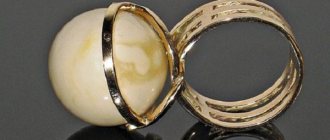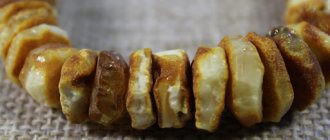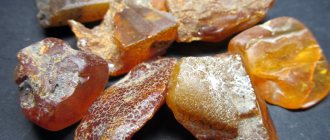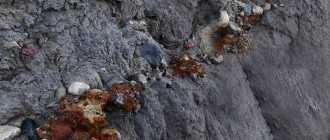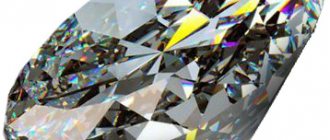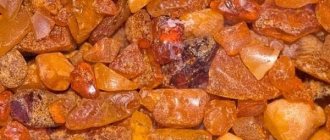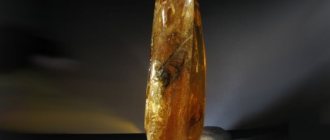It’s not for nothing that many people associate the Kaliningrad region with amber. After all, it is the western region of Russia that is rightfully considered the center of the world amber mining and processing industry. We have about eighty percent of the world's reserves of “sun stone”, which has become a brand of the westernmost region of Russia.
The Kaskad.tv correspondent conducted a little research and learned a lot of interesting things from the history of amber mining in the territory of the former East Prussia.
Amber is accounting and control!
A rethinking of the true value of fossilized resin occurred with the appearance of the Teutonic Order on the lands of Prussia. The Crusaders created an entire amber mining system, completely monopolizing the profitable business. At the head of the department created by the Teutons was the Bernsteinmeister, who controlled the process of collecting stone, putting it on stream.
One of these controller-trustees was Andres Meyer, who introduced the digging of amber from the ground. The first mines appeared in the vicinity of the modern village of Yantarny in 1558.
The extracted raw materials were placed at the disposal of the Marshal, who redirected the amber to the Trading House of the Teutonic Order. Moreover, the profit of this trading organization was about twenty percent of the cost of sold raw amber. The proceeds from the sale of amber went to the needs of the ever-warring crusaders. In general, the Order’s treasury was constantly replenished with considerable “amber money”.
An unexpected continuation of the story. How to export amber by plane
As you might guess, in the evening, during a call with relatives, I boasted about my luck and said that I was bringing everyone a real souvenir from Kaliningrad. To this, almost every interlocutor asked me: “How are you going to take it out? They won’t catch you at the airport?”
Frankly, this question took me by surprise. After a short conversation with the Internet, it turned out that all the amber that can be found in the Kaliningrad region is the property of the state. Consequently, I needed to immediately go where I should and hand over my find in the proper manner.
Then a saving information thread was found. You can take out a certain amount of amber for your own needs. True, the concept of “own needs” is very flexible. For some, a few pieces are enough for souvenirs for relatives. Give others a whole bag.
How to be? On the one hand, I wanted to bring the “pieces of sun” I found from Kaliningrad. On the other hand, if during the search they find them on me... what will happen then?
The solution was found quite quickly. I simply bought a bag of raw amber for a hundred rubles and hid my find among it in a separate bag so as not to mix it up. So I had an official receipt for the purchase, and with it there was no need to fear any troubles.
As it turned out later, no one at the airport was interested in my pitiful couple of dozen pebbles and even a whole bag of them. They didn’t ask me any questions about “are you carrying amber?” It was in vain that I kept my life-saving cash receipt ready in my pocket. The inspection procedure was the same as in all other air ports.
Hence the conclusion. If you find several pieces of amber on the shores of the Baltic Sea, you can safely carry it in your luggage or hand luggage. Nobody will tell you anything. Now, if I had brought a whole potato sack full of yellow pieces to the airfield, questions might arise here. True, if I had presented a receipt confirming the purchase, then in this case everything would have been fine.
If the supporting document had not been found, a completely different conversation would have taken place. It would be considered that I was going to rob the state by illegally mining amber.
"Amber Court"
Amber was processed by specially trained craftsmen, who made various souvenirs and jewelry from it. Amber rosaries, used by priests and nobles, were especially in demand.
An interesting detail: in those distant times, there was an “Amber Court”, which passed harsh sentences for the illegal mining and sale of “sunstone”. Moreover, violators of the law were even given death sentences. The court and residence of the Bernsteinmeister were at one time located in the settlement of Germau (Russkoye settlement, Zelenograd urban district).
Origin of elite gems
Mikhail Lomonosov proved that amber is the hardened resin of prehistoric coniferous trees. Kaliningrad gem is succinite, which belongs to hard and plastic fossil resins.
European and US experts highly value the wide color palette, depth and transparency of Kaliningrad stone. The amber room that disappeared without a trace and exclusive products for royalty were made from Baltic amber.
Artistic value of the stone
The main criterion for evaluating amber is its natural transparency, color and flexibility for polishing. Absolutely transparent stones belong to the highest quality category. For expensive designer jewelry, transparent gems of rare blue, red, green colors and specimens with inclusions of insects and plants are selected.
Classification
| Name | Transparency | Color | Polishability | Voids, mm sq. |
| Transparent | colorless | Faint shade of yellow, red | + | — |
| Smoky | cloudy | light, dark yellow, blue, red | + | 600 |
| Bastard | Medium transparency, with dark spots | yellow | + | 2500 |
| Bone | Doesn't show through | white | + | 900 000 |
| Porous | foamy | white | — | Whole stone |
Steam shovels
The former ship's cabin boy Friedrich Stantien and the merchant Maurice Becker, who created Stantien & Becker in Memel (Klaipeda), achieved considerable financial well-being. On May 20, 1875, this enterprise received the go-ahead from the government for the industrial method of extracting amber in the area of the Palmniken (Yantarny) estate. Powerful excavators powered by steam engines were used. The richest of the mines was a mine named "Anna".
"Zhiguli" - for insects
Craftsman and artist Alexander Lezhnev has been making amber products since the 1990s. In the courtyard of his house (which is also his workshop), Kazan residents were hospitably greeted by amber nesting dolls, a bear, and an imposing cat lounging on a bench. There is also an amber lighthouse, inside of which you can breathe in healthy amber oil. There is almost 2 tons of amber in such large crafts. The cost of raw material depends on its quality and appearance. You can buy 1 g for 55 euros, and a bucket of dug, for example, sells for 50 dollars.
— There are fractions of 300 rubles per kilogram, and some cost half a million or a million. Finished products cost from 500 rubles and above. For every product, even if it lasts for a decade, there is sure to be a buyer. I had beads worth one and a half million for 5 years, but they bought them. Once I was working with a stone that looked ordinary and wanted to cut it. When I started to open it, I noticed something unique there: there was a tree branch inside - also recently bought. In the 90s, when they were still working in garages, neighbors traded a string of beads for a Zhiguli - each bead contained a natural midge, which is more than 45 million years old - a rare thing.
Experts warn that amber can easily be confused with a fake. But you can distinguish it. In addition to the fact that amber floats in salt water and glows under ultraviolet rays, if you rub it, it retains heat and releases the aroma of pine needles. They say that if you take a heated needle and lean it against amber, you will feel a natural aroma, but from plastic you will smell a chemical smell. If you run a sharp object over natural stone, it will crumble, the plastic will be wrapped in shavings, and there will be no traces left on the glass. A drop of acetone will not harm the amber, but will leave streaks on the plastic. Insects positioned perfectly inside the product, as if they were posing, are also a sign of a fake. Of course, in a store no one will allow you to experiment with a needle and acetone, but you need to be careful and pay attention to the price. Among the cheap products on street stalls, there are more fakes.
There is also an amber lighthouse, inside of which you can breathe in healthy amber oil.
In nature, you will not find a smooth, luminous or matte stone with streaks. The beauty of amber is hidden behind a nondescript carbon wrapper. Craftsmen cut and polish the stone, during this process it emits a pleasant aroma of resin; they manage to process up to 300 grams of stone per shift. Sorters sort it, separate it by color, size - everything by hand, very painstaking work. It is unsafe for those who give the stone the final image: the craftsmen work with a cutter, although not too sharp, but their calloused fingers are covered in old cuts. The dust that is generated during cutting and grinding settles in the lungs, so, as a rule, people work in factories wearing masks. Pebbles that the fingers cannot hold are used for decoration.
Envy of the authorities
The use of modern technology made it possible to extract up to seventy-five tons of amber. At that time, the volume of raw materials was considerable. Shtantin and Becker did not succeed in enriching themselves for a long time. The state paid them a multimillion-dollar penalty by terminating the land lease agreement.
As a result, in 1886, Friedrich Shtantin abandoned his once profitable business and returned to his homeland in Memel (Klaipeda). His companion Maurice Becker received the title of commercial advisor, becoming one of the richest people in Königsberg (Kaliningrad). Together with geologist Richard Klebs, who worked as a consultant for Stantien & Becker, he founded an amber museum.
What to do if you find a piece of amber weighing 5-6 kilograms?
First, you need to understand that even if you find such a “piece of sunshine”, it is still not yours. It doesn't matter that he was just lying on the beach. It didn't matter that there was no one around. This is state property. If you are suddenly so lucky (or unlucky, depending on how you look at it), then you can go in four different ways:
Throw it away immediately and leave it where it was.
It is clear that this is inexpressibly painful. It’s a pity, it’s almost impossible to part with such wealth. But... remember the fairy tale about the Little Humpbacked Horse. Ivan found the Firebird's feather and decided to take it for himself despite the admonitions of the Little Humpbacked Horse. Here you are - better listen to me, like the Horse. Throw it away. It’s better not to even take a selfie with the find. You never know who will see this photo posted on social networks! Do you need all these problems?
Sell to the “huckster” from the market
You can stuff your find into a bag and take it to the market where they sell souvenirs. There you can select a trustworthy seller and invite him to contact the owner about purchasing a large piece of amber. It’s probably clear that they won’t give you a lot of money for it, citing poor quality. At best, they will offer to exchange your find for some ready-made ring or pendant.
Take it to the police
This is worth doing if you don't want to mess with the next option. Your action will certainly be appreciated, your find will be formalized as it should be. I don't think you'll ever see her again. You can try to appeal to the law on treasures. After all, if you find a treasure, and this is what happened, you are entitled to a quarter of its value. Purely theoretically, this line can be followed to the end, but then you will have to be patient while experts examine your find and determine its value. Just don’t think that they’ll give you a million or two as compensation. Amber is not such an expensive material. Here is the price of a piece the size of a fist (the photo was taken in the Yantarny Castle in the village of Yantarny):
So for all your running around, nerves and expectations, you will receive 1-2 thousand rubles. Do you need it? I told you, it's better to throw it away right away 
Take to the Yantarny plant in the village of Yantarny
This is where the right staff of specialists and laboratory are located to determine the true value of your nugget. Of course, it will take some resources and time to get to the village of Yantarny, but your find will go straight to its destination, and you will save yourself from risks. After all, even if by some miracle you are able to take the nugget with you, you will not be able to “openly own” it. At any moment you can get into such trouble that you will have to regret that you did not take advantage of recommendations 3, 4, or at least 1 at one time.
I hope you didn't take option 2 seriously. I brought it up as one of the possible, but undesirable ones. Everyone must decide for themselves how to manage their luck. For me, it’s better to act within the law, because a quiet life is also worth something 
- Back
"Walter is a long-liver"
Over the years, the process of amber mining has evolved. The number of mines increased and quarries were built. One of the “long-lived quarries”, which was in operation for almost sixty years, was the open-pit mine “Walter”, founded at the Palmnikenskoye deposit in 1912. Its depth was sixty meters, with a layer thickness of 5-7 meters.
At the beginning of the twentieth century, the treasury of East Prussia received billions of marks annually from the sale of mined amber. Extraction of “sunstone” using open-pit mining turned out to be more profitable.
Healing magic of beauty
The ability to ignite, emit a pleasant aroma and burn with a bewitchingly beautiful flame has given rise to many legends about the healing and energetic properties of amber. In Rus', the gem was considered a sea amulet, added to incense, and used during church services.
Medicine has confirmed the positive effect of the stone as a natural biostimulant. In the sanatorium of the Kaliningrad region there is a medical amber room for the treatment and rehabilitation of children with psychoneurological problems.

